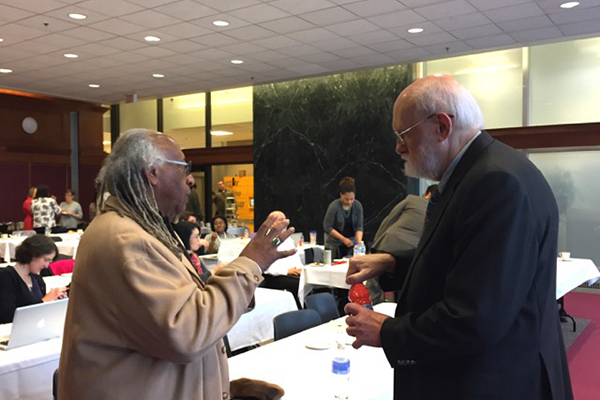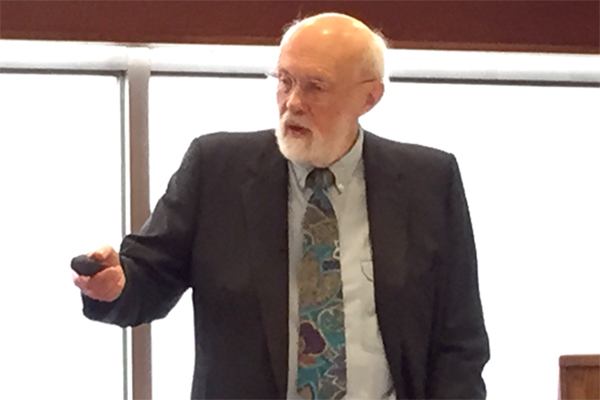


Student success strategies
Beyond test scores: Sedlacek offers eight ways to gauge student potential
11:33 a.m., April 14, 2015--Hold the diversity buzzwords and the statistical window dressing. Bill Sedlacek was serving up none of that. If a quick facelift or public relations campaign was the goal, there was no need to understand the research he has done during his 40-year tenure at the University of Maryland.
But if the goal is to build an academic enterprise that works for a diverse population, if the University of Delaware wants to build an environment that welcomes and supports students from different backgrounds and helps them succeed in their academic pursuits, Sedlacek said his eight strategies would help identify the best candidates.
Campus Stories
From graduates, faculty
Doctoral hooding
Sedlacek, author of Racism in American Education and Beyond the Big Test, visited UD on Thursday, April 9, as part of the Center for the Study of Diversity's series on "Transforming Student Success."
The series presents the research behind efforts to build and support diverse student populations, especially for students who have not traditionally been part of the equation – international students, racial minorities, women, older students, sexual minorities, people with disabilities, for example.
The issue is of pivotal significance for UD, which has made diversity one of the pillars of its strategic plan.
"The series has provided an opportunity to start the dialogue that is critical to the University that we are and the University we want to be in terms of the impact we need to make and want to make," said Christopher Lucier, vice president for enrollment management.
Test scores are one measure of a prospective student, true. And without proper background and content mastery, students are more likely to struggle than succeed. In fields such as engineering, for example, there is no substitute for a strong grasp of mathematics.
But tests are not infallible, grades can be inflated and course work is hard to evaluate, Sedlacek said. Such information produces a one-size-fits-all approach to enrollment, he said, and says little about the kind of support that would help students persevere and achieve from the first semester through graduation.
Test scores say little about leadership, resourcefulness, community engagement, which are among the "noncognitive" traits he says mark a student with high potential.
"Quantitative measures have merit and value, but are they truly predictive of a student's opportunity for success?" Lucier asked. "If you decide to bring students in who may lack pieces in their academic preparation, how do we lift them up? How do we tie them in to the type of community they need to be successful? There are no quick answers. It will require hard work from all."
UD's evaluation process already is extensive, Lucier said, with about 27,000 applications to consider in a five-month period. Some kinds of "noncognitive" measures – as Sedlacek calls them – are part of that process now.
Sedlacek's recommendations could add more layers of inquiry or replace some now in use. There is no need to throw out what has been used, he said. But research shows other variables are useful and could be especially helpful when evaluating students who are "on the cusp and might not make it otherwise," he said.
And beyond the admissions process, Sedlacek's methods point to effective ways faculty and other advisers can support and guide students through to graduation.
With a disarming wave to his critics – yes, he is a white male and no, his methods won't end world hunger – Sedlacek sketched out eight ways to evaluate prospective students that he believes provide more insight than test scores, grades or other transcript data alone can offer.
And, he said, they work equally well for community colleges and the most selective Ivy League institutions.
His "noncognitive variables" include:
- Positive self-concept: The student demonstrates confidence, strength of character, determination, independence.
- Realistic self-appraisal: The student recognizes and accepts strengths and deficiencies, especially academic, and works at self-development.
- Understanding how to handle the system. The student exhibits a realistic view of the system based upon personal experience, is committed to improving the system, takes an assertive approach to dealing with wrongs, but is not hostile and does not use these realities as a cop out. For example, students may experience racism, but instead of running from it or seething with anger they confront it and use it to their advantage.
- Preference for long-range goals. The student is able to plan ahead, set goals and defer gratification.
- Availability of strong support person. The student seeks and takes advantage of a strong support person or network.
- Demonstrated leadership. The student may have provided leadership in other areas of life – church, sports, even gangs.
- Community service. The student participates and is involved in his or her community.
- Nontraditional learning. The student acquires knowledge in fields outside of school.
Adopting some of these measures can be time and labor intensive – a hard sell when staffing and budget pressures are high.
"It is easier to take the scores they send you," Sedlacek agreed. "You have to decide how much struggle do you want to go through? You have to get past the pretense."
Supports and student services must be readily available as soon as students arrive, he said, and such programs may be a hard sell, too.
"A lot of times this is considered superfluous stuff," he said. "But students who do better have some group activity they participate in."
Sedlacek acknowledged that some faculty and students have no interest in promoting and supporting diverse populations.
"They see this as a lot of hand-holding nonsense and say we shouldn't do that for kids," he said.
The research shows otherwise, he said, and anyone in academic endeavors should recognize the value of innovation and efforts to advance.
"Don't assume that everyone does this stuff for the same reasons," he said.
Business students, for example, may see the value of skills and cultural insights that will help them sell more pizzas or provide services that are more marketable globally.
And be honest about your own prejudices, he said.
"Ask yourself, ‘Who don't I like to work with?’ Everybody's got 'em."
Charlotte Marshall, a graduate assistant who works with the UD Scholars program, was glad she attended.
"It was interesting and something I'll follow," she said. "He's got the empirical data and a lot of great points."
James Jones, director of UD's Center for the Study of Diversity and professor of social psychology, said he sees increasing evidence of real change.
"I am very excited by the prospects of where we're heading and the probabilities we're going to get there," he said.
Article and photo by Beth Miller









